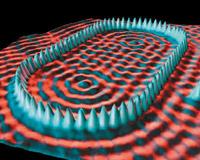Tunnel effect microscope
2000/11/01 Roa Zubia, Guillermo - Elhuyar Zientzia Iturria: Elhuyar aldizkaria
In 1981, at IBM headquarters in Zurich, physicists Heinrich Rohrer and Gerd Karl Binnig took a big step forward. The equations of quantum mechanics announced the ability of electrons to jump from one molecule to another. At least there was real probability. By the hand of this idea was invented the most accurate microscope obtained in history (Scanning Tunnel Microscope, STM).
Electrons can jump from a metallic needle to any surface, although the distance between them is large. So, if the needle passes over the surface, more electrons will jump when that distance is smaller (for example, when an atom of the surface is above others) and the intensity of the electric current will increase. From there, the STM can perform a representation of this surface at atomic level. It is a way to "see" atoms. In addition, if a great interaction is achieved, this instrument is capable of capturing and displacing the atom. In this way, the desired structures can be created, including nanomissions.

Gai honi buruzko eduki gehiago
Elhuyarrek garatutako teknologia





